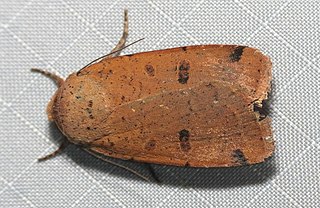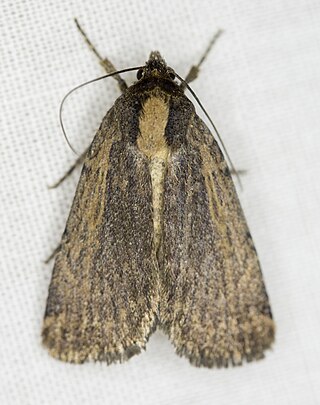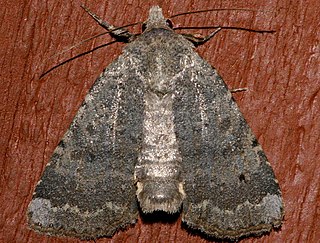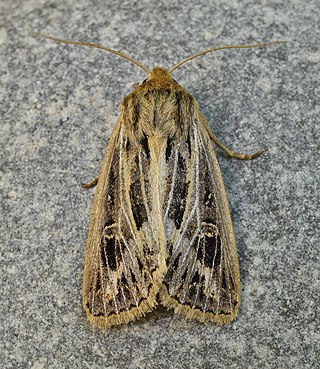
Abagrotis is a genus of moths of the family Noctuidae.

Abagrotis alternata, the greater red dart or mottled gray cutworm, is a moth of the family Noctuidae. The species was first described by Augustus Radcliffe Grote in 1865. It is found in eastern North America, from New Brunswick west across southern Canada to western Alberta, south to Arizona, New Mexico and the Gulf of Mexico.

Abagrotis brunneipennis, the Yankee dart, is a moth of the family Noctuidae. The species was first described by Augustus Radcliffe Grote in 1875. It is found in North America from Newfoundland west to Vancouver Island, south to west central Oregon, Utah, Colorado and North Carolina.

Abagrotis cupida, the Cupid dart or brown climbing cutworm, is a moth of the family Noctuidae. The species was first described by Augustus Radcliffe Grote in 1865. It is found in southern Canada and in the United States east of the Rocky Mountains.

Abagrotis discoidalis is a moth of the family Noctuidae first described by Augustus Radcliffe Grote in 1876. It is found North America in Washington, Oregon and California, west to northern Arizona and New Mexico, Colorado and north into southern Alberta.
Abagrotis erratica is a moth of the family Noctuidae first described by Smith in 1890. It is found in North America from southern British Columbia including Vancouver Island south to central Utah and central California. It is also found in extreme southern Alberta.

Abagrotis mirabilis is a moth of the family Noctuidae first described by Augustus Radcliffe Grote in 1879. It is found in western North America, from British Columbia south to California.

Abagrotis nanalis is a moth of the family Noctuidae first described by Augustus Radcliffe Grote in 1881. It is found in North America from southern British Columbia east to southwest Saskatchewan and western North Dakota, south to northern New Mexico and California.
Abagrotis nefascia is a moth of the family Noctuidae first described by Smith in 1908. It is found in North America from Alberta and British Columbia down through Massachusetts to California. The species is listed as threatened in the US state of Connecticut.

Abagrotis scopeops is a moth of the family Noctuidae first described by Harrison Gray Dyar Jr. in 1904. It is found in North America from southern British Columbia, south through western Montana, Idaho, Utah and Nevada down to southern California.

Abagrotis variata is a moth of the family Noctuidae first described by Augustus Radcliffe Grote in 1876. It is found in North America from British Columbia to California, east to New Mexico and Alberta.
Abagrotis vittifrons is a moth of the family Noctuidae first described by Augustus Radcliffe Grote in 1864. It is found in North America from eastern North Dakota and south-western Saskatchewan west to the southern interior of British Columbia, south to southern California, Arizona and New Mexico.

Agrotis vetusta, the old man dart, spotted-legged cutworm or muted dart is a moth of the family Noctuidae. The species was first described by Francis Walker in 1865. It is found in North America, from southern Alaska to Nova Scotia, southward into Mexico.

Apamea niveivenosa, the snowy-veined apamea, is a moth of the family Noctuidae. The species was first described by Augustus Radcliffe Grote in 1879. It is native to northern North America, where it can be found across Canada and south to California.

Apamea plutonia, the dusky Quaker or dusky apamea, is a moth of the family Noctuidae. The species was first described by Augustus Radcliffe Grote in 1883. It is native to northern North America, where it occurs across the boreal regions, with some occurrences from as far south as New Mexico and Pennsylvania.

Globia oblonga, the oblong sedge borer, is a moth of the family Noctuidae. The species was first described by Augustus Radcliffe Grote in 1882. It is found in parts of Canada and the United States

Schinia nuchalis, the spotted sage moth, is a moth of the family Noctuidae. The species was first described by Augustus Radcliffe Grote in 1878. It is found from the Great Plains and Great Basin, from southern Saskatchewan, Alberta and British Columbia south to northern Arizona. The Eurasian Schinia scutosa is no longer considered a synonym of Schinia nuchalis.

Schinia villosa, the little dark gem, is a moth of the family Noctuidae. The species was first described by Augustus Radcliffe Grote in 1864. In North America, it is mostly a western mountain species, however it has also been found across the plains eastward across Alberta and Saskatchewan to southern Manitoba. To the west it is found up to the coast ranges of Washington and British Columbia, south to Arizona.
Xestia normaniana, or Norman's dart, is a moth of the family Noctuidae. The species was first described by Augustus Radcliffe Grote in 1874. It is found in North America from Nova Scotia across southern and central Canada to Alberta. In the eastern United States it ranges from Maine to eastern Minnesota, and south along the Appalachians to western North Carolina. It has recently been recorded from Tennessee.
Abagrotis kirkwoodi is a species of cutworm or dart moth in the family Noctuidae. It is found in North America.














